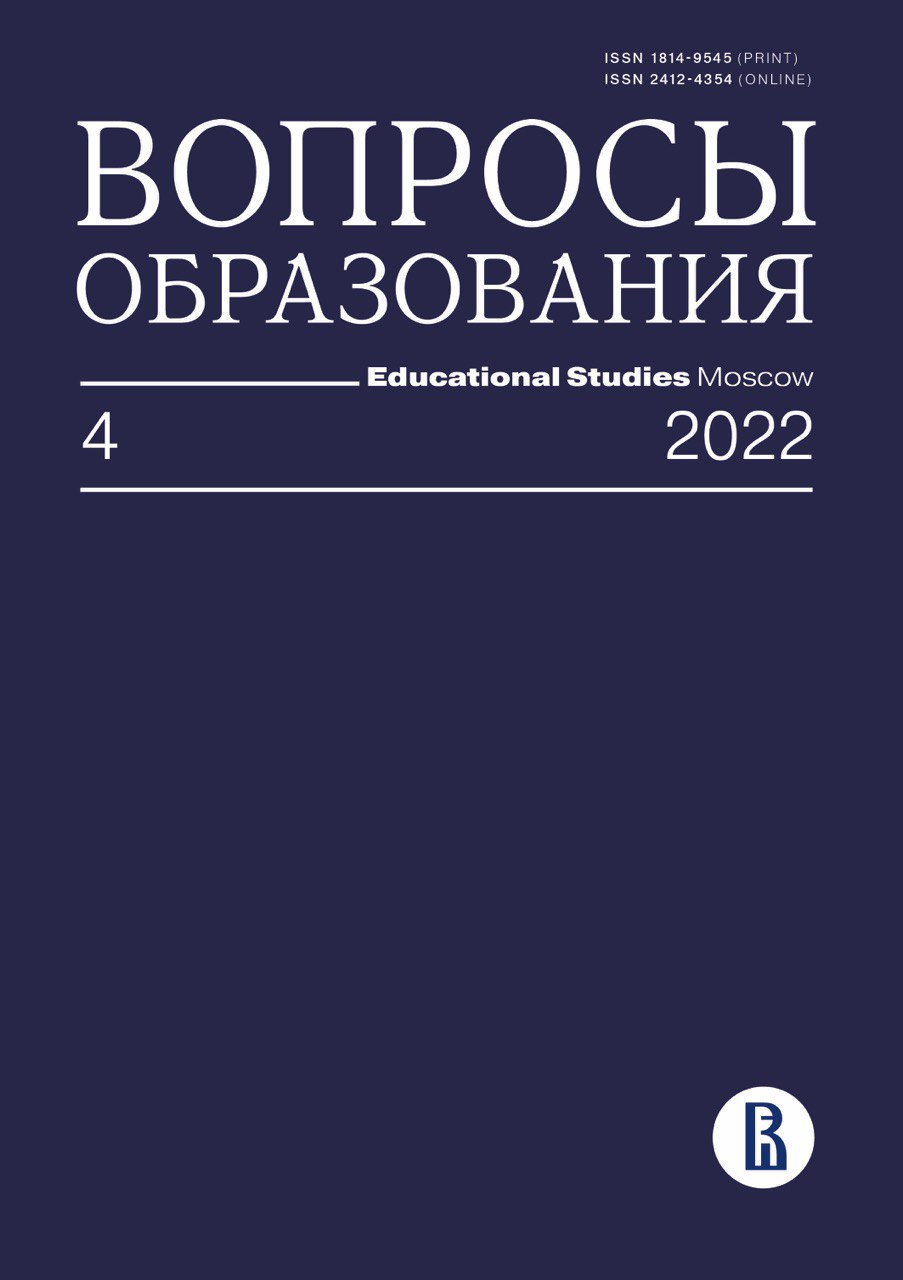School Environment Perceptions of the Young Women with Anorexia: Biographical Reconstruction
Abstract
Anorexia nervosa is the restrictive eating disorder and women are at the highest risk of its development in their teens. Although existing Western scientific literature provides some information on this condition among schoolers, there is the lack of qualitative descriptions that may shed light on the actual experiences and assumptions about the school environment which get girls with anorexia, who continue their education in school or finished it in non-Western countries. In this paper, to show how girls with anorexia perceive school environment I examine 50 in-depth biographical interviews with women who have been diagnosed with anorexia from Russia, Belarus, Ukraine, and Kazakhstan (aged between 14–25 years old). These interviews were combined with the collection of ego networks, using concentric circles methodology, and analysis of unsolicited online diaries belonging to these girls. The data was harvested in the Summer-Autumn of 2020. First, the data analysis revealed four meanings that anorexia has for women in connection with schooling: anorexia as a distraction from education, anti-stress remedy, hobby, and part of a general perfectionist orientation. Second, the data demonstrated the roles of teachers and classmates in the entire system of social connections that the girls with anorexia have, and their importance for the development of the girls’ views on food and body image. Findings suggest that although schools emphasize perfectionism, academic achievements, and disciplinary culture, the school’s role in the life of girls with anorexia is greatly determined by parental attitudes towards education.
Downloads
References
Adamchuk D.V., Arinushkina A.A., Neustroev S.S. (2020) Satisfaction of Parents of Schoolchildren with Various Aspects of the Food Management System at Schools: Data from Russia. Data in Brief, vol. 31, August, Article no 105725. https://doi.org/10.1016/j.dib.2020.105725
Allen K.L., Byrne S.M., Oddy W.H., Crosby R.D. (2013) Early Onset Binge Eating and Purging Eating Disorders: Course and Outcome in a Population-Based Study of Adolescents. Journal of Abnormal Child Psychology, vol. 41, no 7, pp. 1083–1096. https://doi.org/10.1007/s10802-013-9747-7
Arcelus J., Mitchell A.J., Wales J., Nielsen S. (2011) Mortality Rates in Patients with Anorexia Nervosa and Other Eating Disorders: A Meta-analysis of 36 Studies. Archives of General Psychiatry, vol. 68, no 7, pp. 724–731. https://doi.org/10.1001/archgenpsychiatry.2011.74
Barratt M.J., Ferris J.A., Lenton S. (2015) Hidden Populations, Online Purposive Sampling, and External Validity: Taking Off the Blindfold. Field Methods, vol. 27, no 1, pp. 3–21. https://doi.org/10.1177/1525822X14526838
Bellotti E. (2016) Qualitative Methods and Visualizations in the Study of Friendship Networks. Sociological Research Online, vol. 21, no 2, pp. 198–216. https://doi.org/10.5153/sro.3936
Berg K.M., Dermot J.H., McSherry J.A., Strange N.E. (2016) Eating Disorders: A Patient-Centered Approach. Boca Raton, FL: CRC.
Bould H., De Stavola B., Lewis G., Micali N. (2018) Do Disordered Eating Behaviours in Girls Vary by School Characteristics? A UK Cohort Study. European Child & Adolescent Psychiatry, vol. 27, no 11, pp. 1473–1481. https://doi.org/10.1007/s00787-018-1133-0
Bould H., De Stavola B., Magnusson C., Micali N., Dal H., Evans J., Dalman C., Lewis G. (2016) The Influence of School on Whether Girls Develop Eating Disorders. International Journal of Epidemiology, vol. 45, no 2, pp. 480–488. https://doi.org/10.1093/ije/dyw037
Braun V., Clarke V. (2012) Thematic Analysis. APA Handbook of Research Methods in Psychology. Vol. 2: Research Designs: Quantitative, Qualitative, Neuropsychological, and Biological (eds H.M. Cooper, P.M. Camic, D.L. Long, A.T. Panter, D. Rindskopf, K.J. Sher), Washington, DC: American Psychological Association, pp. 57–71. https://doi.org/10.1037/13620-004
Chen A., Couturier J. (2019) Triggers for Children and Adolescents with Anorexia Nervosa: A Retrospective Chart Review. Journal of the Canadian Academy of Child and Adolescent Psychiatry, vol. 28, no 3, pp. 134–140.
Copeland W.E., Bulik C.M., Zucker N., Wolke D., Lereya S.T., Costello E.J. (2015) Is Childhood Bullying Involvement a Precursor of Eating Disorder Symptoms? A Prospective Analysis. The International Journal of Eating Disorders, vol. 48, no 8, pp. 1141–1149. https://doi.org/10.1002/eat.22459
Cortés-García L., Hoffmann S., Warschburger P., Senra C. (2019) Exploring the Reciprocal Relationships between Adolescents' Perceptions of Parental and Peer Attachment and Disordered Eating: A Multiwave Cross-Lagged Panel Analysis. International Journal of Eating Disorders, vol. 52, no 8, pp. 924–934. https://doi.org/10.1002/eat.23086
Dahlenburg S.C., Gleaves D.H., Hutchinson A.D. (2019) Anorexia Nervosa and Perfectionism: A Meta-Analysis. International Journal of Eating Disorders, vol. 52, no 3, pp. 219–229. https://doi.org/10.1002/eat.23009
Doba K., Nandrino J.-L., Lesne A., Humez C., Pezard L. (2008) Organization of the Narrative Components in Autobiographical Speech of Anorexic Adolescents: A Statistical and Non-Linear Dynamical Analysis. New Ideas in Psychology, vol. 26, no 2, pp. 295–308. https://doi.org/10.1016/j.newideapsych.2007.07.004
Evans J., Rich E., Davies B., Allwood R. (2005) The Embodiment of Learning: What the Sociology of Education Doesn't Say about "Risk" in Going to School. International Studies in Sociology of Education, vol. 15, no 2, pp. 129–148. https://doi.org/10.1080/09620210500200136
Evans J., Rich E., Holroyd R. (2004) Disordered Eating and Disordered Schooling: What Schools Do to Middle Class Girls. British Journal of Sociology of Education, vol. 25, no 2, pp. 123–142. https://doi.org/10.1080/0142569042000205154
Falstein E.I., Feinstein S.C., Judas I. (1956) Anorexia Nervosa in the Male Child. American Journal of Orthopsychiatry, vol. 26, no 4, pp. 751–772. https://doi.org/10.1111/j.1939-0025.1956.tb06220.x
Galmiche M., Déchelotte P., Lambert G., Tavolacci M.P. (2019) Prevalence of Eating Disorders over the 2000-2018 Period: A Systematic Literature Review. The American Journal of Clinical Nutrition, vol. 109, no 5, pp. 1402–1413. https://doi.org/10.1093/ajcn/nqy342
Ghai S. (2021) It's Time to Reimagine Sample Diversity and Retire the WEIRD Dichotomy. Nature Human Behaviour, vol. 5, no 8, pp. 971–972. https://doi.org/10.1038/s41562-021-01175-9
Halse C., Honey A., Boughtwood D. (2007) The Paradox of Virtue: (Re)Thinking Deviance, Anorexia and Schooling. Gender and Education, vol. 19, no 2, pp. 219–235. https://doi.org/10.1080/09540250601166068
Jones E.J., Egan S.J., Howell J.A., Hoiles K.J., Mazzucchelli T.G. (2020) An Examination of the Transdiagnostic Cognitive-Behavioural Model of Eating Disorders in Adolescents. Eating Behaviors, vol. 39, December, Article no 101445. https://doi.org/10.1016/j.eatbeh.2020.101445
Keshaviah A., Edkins K., Hastings E.R., Krishna M. et al. (2014) Re-Examining Premature Mortality in Anorexia Nervosa: A Meta-Analysis Redux. Comprehensive Psychiatry, vol. 55, no 8, pp. 1773–1784. https://doi.org/10.1016/j.comppsych.2014.07.017
Knightsmith P., Sharpe H., Breen O., Treasure J., Schmidt U. (2014) 'My Teacher Saved My Life' Versus "Teachers Don't Have a Clue": An Online Survey of Pupils' Experiences of Eating Disorders. Child and Adolescent Mental Health, vol. 19, no 2, pp. 131–137. https://doi.org/10.1111/camh.12027
Knightsmith P., Treasure J., Schmidt U. (2014) We Don't Know How to Help: An Online Survey of School Staff. Child and Adolescent Mental Health, vol. 19, no 3, pp. 208–214. https://doi.org/10.1111/camh.12039
Krafchek J., Kronborg L. (2020) The Social Coping of Academically High-Achieving Females before the Onset of Disordered Eating. Gifted and Talented International, vol. 35, no 2, pp.86–99. https://doi.org/10.1080/15332276.2020.1818329
Lie S., Rø Ø., Bang L. (2019) Is Bullying and Teasing Associated with Eating Disorders? A Systematic Review and Meta-Analysis. International Journal of Eating Disorders, vol. 52, no 5, pp. 497–514. https://doi.org/10.1002/eat.23035
Liu C., Cox R.B., Washburn I.J., Croff J.M., Crethar H.C. (2017) The Effects of Requiring Parental Consent for Research on Adolescents' Risk Behaviors: A Meta-Analysis. Journal of Adolescent Health, vol. 61, no 1, pp. 45–52. https://doi.org/10.1016/j.jadohealth.2017.01.015
Maksimov S., Karamnova N., Shalnova S., Drapkina O. (2020) Sociodemographic and Regional Determinants of Dietary Patterns in Russia. International Journal of Environmental Research and Public Health, vol. 17, no 1, Article no 328. https://doi.org/10.3390/ijerph17010328
Mang L., Ridout N., Dritschel B. (2018) The Influence of Mood and Attitudes towards Eating on Cognitive and Autobiographical Memory Flexibility in Female University Students. Psychiatry Research, vol. 269, November, pp. 444–449. https://doi.org/10.1016/j.psychres.2018.08.055
Mangweth B., Hausmann A., Danzl C., Walch T., Rupp C.I., Biebl W., Hudson J.I., Pope Jr H.G. (2005) Childhood Body-Focused Behaviors and Social Behaviors as Risk Factors of Eating Disorders. Psychotherapy and Psychosomatics, vol. 74, no 4, pp. 247–253. https://doi.org/10.1159/000085149
Meyer T.A., Gast J. (2008) The Effects of Peer Influence on Disordered Eating Behavior. The Journal of School Nursing, vol. 24, no 1, pp. 36–42. https://doi.org/10.1159/000085149
Mikhaylova O. (2022) Measuring Moral Panic Propagation on the Interpersonal Level: Case of Pro-ana Women Bloggers. Interaction. Interview. Interpretation, vol. 14, no 1, pp. 33–57. https://doi.org/10.19181/inter.2022.14.1.2
Mikhaylova O., Bochaver A. (2022) Family Environment Hostility as the Missing Element between School Bullying Victimization and Anorexia. Frontiers in Education, vol. 7, May, Article no 880994. https://doi.org/10.3389/feduc.2022.880994
Mikhaylova O., Dokuka S. (2022) Anorexia and Young Womens' Personal Networks: Size, Structure, and Kinship. Frontiers in Psychology, vol. 13, April, Article no 848774. https://doi.org/10.3389/fpsyg.2022.848774
Ridout N., Matharu M., Sanders E., Wallis D.J. (2015) The Influence of Eating Psychopathology on Autobiographical Memory Specificity and Social Problem-Solving. Psychiatry Research, vol. 228, no 3, pp. 295–303. https://doi.org/10.1016/j.psychres.2015.06.030
Schiele B., Weist M.D., Martinez S., Smith-Millman M., Sander M., Lever N. (2020) Improving School Mental Health Services for Students with Eating Disorders. School Mental Health, vol. 12, no 4, pp. 771–785. https://doi.org/10.1007/s12310-020-09387-6
Sharpe H., Schober I., Treasure J., Schmidt U. (2014) The Role of High-Quality Friendships in Female Adolescents' Eating Pathology and Body Dissatisfaction. Eating and Weight Disorders: EWD, vol. 19, no 2, pp. 159–168. https://doi.org/10.1007/s40519-014-0113-8
Shpakovskaya L. (2015a) Obrazovatel'nye prityazaniya roditeley kak mekhanizm vosproizvodstva sotsial'nogo neravenstva [The Educational Expectations of Parents: A Mechanism that Reproduces Social Inequality]. The Journal of Social Policy Studies, vol. 13, no 2, pp. 211–224.
Shpakovskaya L. (2015b) How to Be a Good Mother: The Case of Middle Class Mothering in Russia. Europe-Asia Studies, vol. 67, no 10, pp. 1571–1586. https://doi.org/10.1080/09668136.2015.1101210
Soban C. (2006) What about the Boys? Addressing Issues of Masculinity within Male Anorexia Nervosa in a Feminist Therapeutic Environment. International Journal of Men's Health, vol. 5, no 3, pp. 251–267. https://doi.org/10.3149/jmh.0503.251
Sormunen,M., Goranskaya S., Kirilina V., Bykachev K., Tossavainen K. (2018) Home and School Responsibilities for Children's Health Literacy Development: The Views of Finnish and Russian Parents and Teachers. Russian Journal of Communication, vol. 10, no 1, pp. 70–90. https://doi.org/10.1080/19409419.2017.1381570
Tapia-Fonllem C., Fraijo-Sing B., Corral-Verdugo V., Garza-Terán G., Moreno-Barahona M. (2020) School Environments and Elementary School Children's Well-Being in Northwestern Mexico. Frontiers in Psychology, vol. 11, March, pp. 1-8. https://doi.org/10.3389/fpsyg.2020.00510
Waes van S., van den Bossche P. (2019) Around and Around: The Concentric Circles Method as Powerful Tool to Collect Mixed Method Network Data. Mixed Methods Approaches to Social Network Analysis (eds D.E. Froehlich, M. Rehm, B. Rienties), London: Routledge, pp. 159–174. https://doi.org/10.4324/9780429056826-15
Westwood H., Lawrence V., Fleming C., Tchanturia K. (2016) Exploration of Friendship Experiences, before and after Illness Onset in Females with Anorexia Nervosa: A Qualitative Study. Plos ONE, vol. 11, no 9, pp. 1–16. https://doi.org/10.1371/journal.pone.0163528
Copyright (c) 2022 Authors retain copyright and accept the terms of publication in the journal (https://vo.hse.ru/copyright)

This work is licensed under a Creative Commons Attribution-NonCommercial 4.0 International License.









